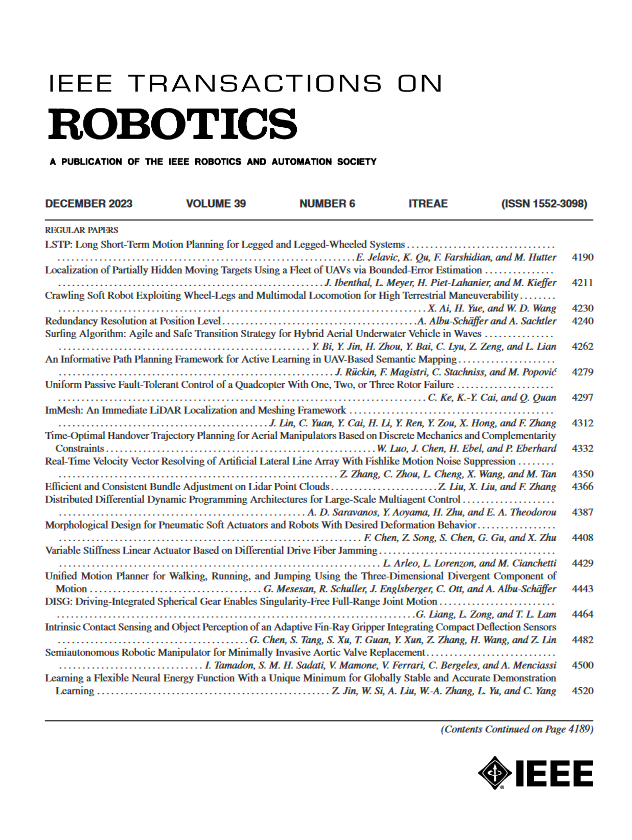欠驱动双足在崎岖地形上行走的感知混合整数步态控制
IF 10.5
1区 计算机科学
Q1 ROBOTICS
引用次数: 0
摘要
穿越崎岖的地形需要动态的两足动物通过脚的放置来稳定自己,而不会进入不安全的区域。考虑到安全地形的非凸性和不完善的感知和状态估计,在线规划这些足迹是具有挑战性的。本文通过一个全栈感知和控制系统来解决这些挑战,以实现在不连续地形上的欠驱动行走。首先,我们开发了模型预测的脚步控制,这是一个单一的混合整数二次程序,它假设一个凸多边形地形分解,以优化超过100 Hz的离散落脚点选择,脚步位置,脚踝扭矩,模板动力学和脚步定时。然后,我们提出了一种在线生成凸多边形地形分解的新方法。我们的感知堆栈将安全地形分类与拟合平面多边形解耦,使用单个CPU线程实时生成暂时一致的地形分割。我们通过使用欠驱动双足机器人Cassie进行户外实验,展示了我们的感知和控制堆栈的性能,实现了在不连续地形上的最先进的感知双足行走。本文章由计算机程序翻译,如有差异,请以英文原文为准。
Perceptive Mixed-Integer Footstep Control for Underactuated Bipedal Walking on Rough Terrain
Traversing rough terrain requires dynamic bipeds to stabilize themselves through foot placement without stepping into unsafe areas. Planning these footsteps online is challenging given the nonconvexity of the safe terrain and imperfect perception and state estimation. This article addresses these challenges with a full-stack perception and control system for achieving underactuated walking on discontinuous terrain. First, we develop model-predictive footstep control, a single mixed-integer quadratic program, which assumes a convex polygon terrain decomposition to optimize over discrete foothold choice, footstep position, ankle torque, template dynamics, and footstep timing at over 100 Hz. We then propose a novel approach for generating convex polygon terrain decompositions online. Our perception stack decouples safe-terrain classification from fitting planar polygons, generating a temporally consistent terrain segmentation in real time using a single CPU thread. We demonstrate the performance of our perception and control stack through outdoor experiments with the underactuated biped Cassie, achieving state of the art perceptive bipedal walking on discontinuous terrain.
求助全文
通过发布文献求助,成功后即可免费获取论文全文。
去求助
来源期刊

IEEE Transactions on Robotics
工程技术-机器人学
CiteScore
14.90
自引率
5.10%
发文量
259
审稿时长
6.0 months
期刊介绍:
The IEEE Transactions on Robotics (T-RO) is dedicated to publishing fundamental papers covering all facets of robotics, drawing on interdisciplinary approaches from computer science, control systems, electrical engineering, mathematics, mechanical engineering, and beyond. From industrial applications to service and personal assistants, surgical operations to space, underwater, and remote exploration, robots and intelligent machines play pivotal roles across various domains, including entertainment, safety, search and rescue, military applications, agriculture, and intelligent vehicles.
Special emphasis is placed on intelligent machines and systems designed for unstructured environments, where a significant portion of the environment remains unknown and beyond direct sensing or control.
 求助内容:
求助内容: 应助结果提醒方式:
应助结果提醒方式:


